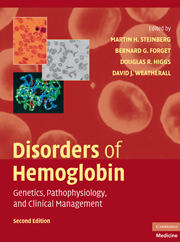Book contents
- Frontmatter
- Contents
- List of Contributors
- Foreword, by H. Franklin Bunn
- Preface
- Introduction, by David J. Weatherall
- SECTION ONE THE MOLECULAR, CELLULAR, AND GENETIC BASIS OF HEMOGLOBIN DISORDERS
- SECTION TWO PATHOPHYSIOLOGY OF HEMOGLOBIN AND ITS DISORDERS
- SECTION THREE α THALASSEMIA
- SECTION FOUR THE β THALASSEMIAS
- SECTION FIVE SICKLE CELL DISEASE
- SECTION SIX OTHER CLINICALLY IMPORTANT DISORDERS OF HEMOGLOBIN
- SECTION SEVEN SPECIAL TOPICS IN HEMOGLOBINOPATHIES
- 26 Population Genetics and Global Health Burden
- 27 Genetic Modulation of Sickle Cell Disease and Thalassemia
- 28 Laboratory Methods for Diagnosis and Evaluation of Hemoglobin Disorders
- SECTION EIGHT NEW APPROACHES TO THE TREATMENT OF HEMOGLOBINOPATHIES AND THALASSEMIA
- Index
- Plate section
- References
28 - Laboratory Methods for Diagnosis and Evaluation of Hemoglobin Disorders
from SECTION SEVEN - SPECIAL TOPICS IN HEMOGLOBINOPATHIES
Published online by Cambridge University Press: 03 May 2010
- Frontmatter
- Contents
- List of Contributors
- Foreword, by H. Franklin Bunn
- Preface
- Introduction, by David J. Weatherall
- SECTION ONE THE MOLECULAR, CELLULAR, AND GENETIC BASIS OF HEMOGLOBIN DISORDERS
- SECTION TWO PATHOPHYSIOLOGY OF HEMOGLOBIN AND ITS DISORDERS
- SECTION THREE α THALASSEMIA
- SECTION FOUR THE β THALASSEMIAS
- SECTION FIVE SICKLE CELL DISEASE
- SECTION SIX OTHER CLINICALLY IMPORTANT DISORDERS OF HEMOGLOBIN
- SECTION SEVEN SPECIAL TOPICS IN HEMOGLOBINOPATHIES
- 26 Population Genetics and Global Health Burden
- 27 Genetic Modulation of Sickle Cell Disease and Thalassemia
- 28 Laboratory Methods for Diagnosis and Evaluation of Hemoglobin Disorders
- SECTION EIGHT NEW APPROACHES TO THE TREATMENT OF HEMOGLOBINOPATHIES AND THALASSEMIA
- Index
- Plate section
- References
Summary
INTRODUCTION
Hemoglobinopathy detection is often a part of the evaluation of anemia, hemolysis, microcytosis, cyanosis, or erythrocytosis. For this purpose, protein (hemoglobin)-, cellular-, and DNA-based approaches to the detection of variant hemoglobins and thalassemias are available. Diagnostic details can be found in each disease-specific chapter, whereas in the following pages we focus on the available methods and their strengths and weaknesses.
Characterization of mutant hemoglobins and thalassemias described throughout this book takes place in different contexts: large newborn screening laboratories that need to identify positively the most common mutants; general hematology laboratories that most often encounter common hemoglobinopathies and thalassemias; and reference or research laboratories that can detect rare mutant globin genes. Approaches that are necessary in one setting might not be practical in others.
Normal adult blood contains predominantly HbA (α2β2) and small amounts of HbF (α2γ2) and HbA2 (α2δ2). After synthesis, monomeric globin chains form α/non-α dimers that do not dissociate under physiological conditions. In the presence of oxygen, hemoglobin tetramers rapidly dissociate into very low concentrations of dimers that can then form new tetramers. This implies that when more than one α- or non-α-chain is present, the predominant form in the red cell will be the heterotetramer (for example, in red cells of HbSC disease, the dominant species will be α2βSβC, and α2βSγ heterotetramers form when HbS is present with high levels of HbF (Fig. 28.1).
- Type
- Chapter
- Information
- Disorders of HemoglobinGenetics, Pathophysiology, and Clinical Management, pp. 658 - 686Publisher: Cambridge University PressPrint publication year: 2009
References
- 3
- Cited by



